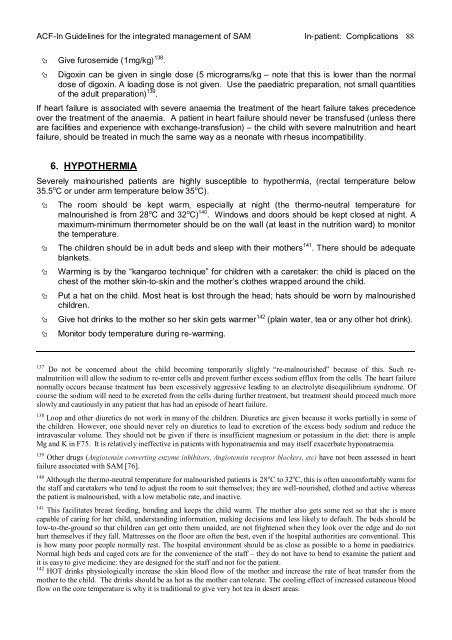guidelines for the integrated management of severe acute malnutrition
guidelines for the integrated management of severe acute malnutrition
guidelines for the integrated management of severe acute malnutrition
You also want an ePaper? Increase the reach of your titles
YUMPU automatically turns print PDFs into web optimized ePapers that Google loves.
ACF-In Guidelines <strong>for</strong> <strong>the</strong> <strong>integrated</strong> <strong>management</strong> <strong>of</strong> SAM In-patient: Complications 88<br />
� Give furosemide (1mg/kg) 138 .<br />
� Digoxin can be given in single dose (5 micrograms/kg – note that this is lower than <strong>the</strong> normal<br />
dose <strong>of</strong> digoxin. A loading dose is not given. Use <strong>the</strong> paediatric preparation, not small quantities<br />
<strong>of</strong> <strong>the</strong> adult preparation) 139 .<br />
If heart failure is associated with <strong>severe</strong> anaemia <strong>the</strong> treatment <strong>of</strong> <strong>the</strong> heart failure takes precedence<br />
over <strong>the</strong> treatment <strong>of</strong> <strong>the</strong> anaemia. A patient in heart failure should never be transfused (unless <strong>the</strong>re<br />
are facilities and experience with exchange-transfusion) – <strong>the</strong> child with <strong>severe</strong> <strong>malnutrition</strong> and heart<br />
failure, should be treated in much <strong>the</strong> same way as a neonate with rhesus incompatibility.<br />
6. HYPOTHERMIA<br />
Severely malnourished patients are highly susceptible to hypo<strong>the</strong>rmia, (rectal temperature below<br />
35.5 o C or under arm temperature below 35 o C).<br />
� The room should be kept warm, especially at night (<strong>the</strong> <strong>the</strong>rmo-neutral temperature <strong>for</strong><br />
malnourished is from 28 o C and 32 o C) 140 . Windows and doors should be kept closed at night. A<br />
maximum-minimum <strong>the</strong>rmometer should be on <strong>the</strong> wall (at least in <strong>the</strong> nutrition ward) to monitor<br />
<strong>the</strong> temperature.<br />
� The children should be in adult beds and sleep with <strong>the</strong>ir mo<strong>the</strong>rs 141 . There should be adequate<br />
blankets.<br />
� Warming is by <strong>the</strong> “kangaroo technique” <strong>for</strong> children with a caretaker: <strong>the</strong> child is placed on <strong>the</strong><br />
chest <strong>of</strong> <strong>the</strong> mo<strong>the</strong>r skin-to-skin and <strong>the</strong> mo<strong>the</strong>r’s clo<strong>the</strong>s wrapped around <strong>the</strong> child.<br />
� Put a hat on <strong>the</strong> child. Most heat is lost through <strong>the</strong> head; hats should be worn by malnourished<br />
children.<br />
� Give hot drinks to <strong>the</strong> mo<strong>the</strong>r so her skin gets warmer 142 (plain water, tea or any o<strong>the</strong>r hot drink).<br />
� Monitor body temperature during re-warming.<br />
137 Do not be concerned about <strong>the</strong> child becoming temporarily slightly “re-malnourished” because <strong>of</strong> this. Such re<strong>malnutrition</strong><br />
will allow <strong>the</strong> sodium to re-enter cells and prevent fur<strong>the</strong>r excess sodium efflux from <strong>the</strong> cells. The heart failure<br />
normally occurs because treatment has been excessively aggressive leading to an electrolyte disequilibrium syndrome. Of<br />
course <strong>the</strong> sodium will need to be excreted from <strong>the</strong> cells during fur<strong>the</strong>r treatment, but treatment should proceed much more<br />
slowly and cautiously in any patient that has had an episode <strong>of</strong> heart failure.<br />
138 Loop and o<strong>the</strong>r diuretics do not work in many <strong>of</strong> <strong>the</strong> children. Diuretics are given because it works partially in some <strong>of</strong><br />
<strong>the</strong> children. However, one should never rely on diuretics to lead to excretion <strong>of</strong> <strong>the</strong> excess body sodium and reduce <strong>the</strong><br />
intravascular volume. They should not be given if <strong>the</strong>re is insufficient magnesium or potassium in <strong>the</strong> diet: <strong>the</strong>re is ample<br />
Mg and K in F75. It is relatively ineffective in patients with hyponatraemia and may itself exacerbate hyponatraemia.<br />
139 O<strong>the</strong>r drugs (Angiotensin converting enzyme inhibitors, Angiotensin receptor blockers, etc) have not been assessed in heart<br />
failure associated with SAM [76].<br />
140 Although <strong>the</strong> <strong>the</strong>rmo-neutral temperature <strong>for</strong> malnourished patients is 28 o C to 32 o C, this is <strong>of</strong>ten uncom<strong>for</strong>tably warm <strong>for</strong><br />
<strong>the</strong> staff and caretakers who tend to adjust <strong>the</strong> room to suit <strong>the</strong>mselves; <strong>the</strong>y are well-nourished, clo<strong>the</strong>d and active whereas<br />
<strong>the</strong> patient is malnourished, with a low metabolic rate, and inactive.<br />
141 This facilitates breast feeding, bonding and keeps <strong>the</strong> child warm. The mo<strong>the</strong>r also gets some rest so that she is more<br />
capable <strong>of</strong> caring <strong>for</strong> her child, understanding in<strong>for</strong>mation, making decisions and less likely to default. The beds should be<br />
low-to-<strong>the</strong>-ground so that children can get onto <strong>the</strong>m unaided, are not frightened when <strong>the</strong>y look over <strong>the</strong> edge and do not<br />
hurt <strong>the</strong>mselves if <strong>the</strong>y fall. Mattresses on <strong>the</strong> floor are <strong>of</strong>ten <strong>the</strong> best, even if <strong>the</strong> hospital authorities are conventional. This<br />
is how many poor people normally rest. The hospital environment should be as close as possible to a home in paediatrics.<br />
Normal high beds and caged cots are <strong>for</strong> <strong>the</strong> convenience <strong>of</strong> <strong>the</strong> staff – <strong>the</strong>y do not have to bend to examine <strong>the</strong> patient and<br />
it is easy to give medicine: <strong>the</strong>y are designed <strong>for</strong> <strong>the</strong> staff and not <strong>for</strong> <strong>the</strong> patient.<br />
142 HOT drinks physiologically increase <strong>the</strong> skin blood flow <strong>of</strong> <strong>the</strong> mo<strong>the</strong>r and increase <strong>the</strong> rate <strong>of</strong> heat transfer from <strong>the</strong><br />
mo<strong>the</strong>r to <strong>the</strong> child. The drinks should be as hot as <strong>the</strong> mo<strong>the</strong>r can tolerate. The cooling effect <strong>of</strong> increased cutaneous blood<br />
flow on <strong>the</strong> core temperature is why it is traditional to give very hot tea in desert areas.

















